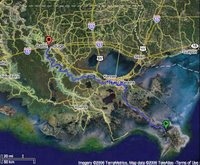 I start off in the morning walking north, near lunchtime I’m walking west, then south, then west, a bit northerly again… so it goes along the Mississippi River Road, snaking along at a moderate pace, watching the barges being pushed and the ships chugging along, above the levee, high on the Mississippi River…
I start off in the morning walking north, near lunchtime I’m walking west, then south, then west, a bit northerly again… so it goes along the Mississippi River Road, snaking along at a moderate pace, watching the barges being pushed and the ships chugging along, above the levee, high on the Mississippi River…
I made it to Donaldsonville slightly ahead of my predicted time so kept walking through. I did stop to read the historic marker in the city: “Town founded by William Donaldson, 1806, on farm of Pierre Landry. Began as trading post about 1750, Home of Governor Francis T. Nicholls and of Dr. F.W. Prevost, who performed first Caesarian section, 1824. Parish seat of Ascension. Capital of Louisiana from January 1830 to January 1831.”
Donaldsonville is located at the confluence of the Mississippi River and Bayou Lafourche. I grew up at the other end of Bayou Lafourche, way “down on the bayou” as we say it, in a town called Cut Off.
Past Donaldsonville, closer to Baton Rouge is a small town called White Castle. The community was named not for a hamburger joint, but for a plantation.

Just 2 miles past White Castle sitting on the edge of the river is one of my favorite places, Nottoway Plantation. It is one of the largest antebellum plantation houses in the south, composed of 64 rooms, 7 staircases, and 5 galleries. This 53,000-square foot plantation home, constructed by John Hampden Randolph in 1858, is a fine example of an antebellum home.
This is where I’ll be tomorrow… sitting on the porch in a rocking chair with a tall glass of iced tea, resting my feet and rocking slowly, in the cool breezes beneath the Live Oaks.
******


John Hampden Randolph planned and built Nottoway, but it was his wife Emily Jane who saved it from destruction.
Emily Jane Liddell Randolph was the mother of ten children when the civil war erupted. In 1862 Randolph took his slaves and went to Texas to work a cotton plantation there in order to keep himself solvent. The Randolphs sent their teenage daughters away to safer territory, and Mrs. Randolph remained on the plantation with the younger children, two visiting lady friends, and a few of her slaves. One of her daughters, Cornelia, kept a diary. It is from this diary as well as from preserved letters and documents that we know of Emily Jane's courage.
At one point in 1862, when she was 45 years old, she faced down the Union Navy. Gun boats were sailing by the house, and union troops had begun to bivouac on the lawn. Armed only with a dagger which she tucked into her belt, she went out on the front gallery. She was determined not to let the union troops into her house. Many houses along the river had been abandoned. These deserted houses if not burned, were destroyed by looting and vandalism. As she stood on the front gallery a group of Confederate soldiers opened fire on the Union troops.
The gun boats on the river returned the fire. Though they were not aiming at the house, much of the fire hit it or landed on the grounds. When the firing became heavy, Emily Jane gathered her children, friends, and slaves and took them all to the ground floor where the walls were four feet thick. When the barrage was over, she alone had the courage to mount the stairs and assess the damage. It was in that same year that Emily Jane gave birth to her eleventh and last child, Julia Marceline. Although the Union army encamped several times on the lawn in the course of the war, they never entered the house except to search for weapons.
Nottoway served as inspiration for the filming of the movie Gone With The Wind. Scarlett O'Hara fashioned her dress from drapes very similar to those seen above hanging in the Randolph study.
 I’ve been walking the River Road all day as it winded along the foot of the levee. It was a pleasant walk, with cool air. Keeping me company were cattle and horses grazing peacefully on the levees under rich blue skies. I’m currently on the west bank of the river opposite Louisiana State University.
I’ve been walking the River Road all day as it winded along the foot of the levee. It was a pleasant walk, with cool air. Keeping me company were cattle and horses grazing peacefully on the levees under rich blue skies. I’m currently on the west bank of the river opposite Louisiana State University.











